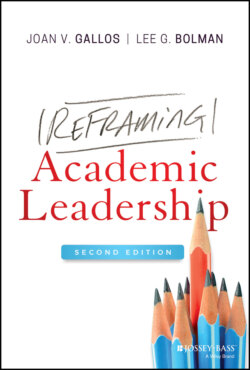Читать книгу Reframing Academic Leadership - Lee G. Bolman - Страница 29
Skilled Incompetence: Understanding Theories for Action
ОглавлениеIn Chapter 2, we argued that sensemaking and learning from experience are at the heart of leadership effectiveness. In looking at how Sarah prepared for and conducted her meeting with George, we can see an example of how everyday sensemaking can go awry and lead well‐intentioned administrators into quagmires while preventing them from having any idea how they got bogged down. Sadly, scenes like this are all too common. The Sarahs of the world dig their way into holes, using unproductive strategies that they have come by honestly. The Georges help them shovel. There's a perfect description for this kind of behavior: skilled incompetence, the use of automatic, learned behaviors to produce the opposite of what you intend (Argyris, 1986). Why does this happen? It is not because people set out to fail – almost no one does that. But in interactions with others, people often know what they intend without realizing that they're not doing what they think they are.
To complicate matters, they often have little or no understanding of the impact of their behaviors on others – and they have not developed habits of the mind to make such inquiry a regular part of their professional practice. As a result, they don't see their responsibility for failed interactions, don't see other options, and often don't recognize the need to search for them. The same ineffective behaviors get repeated again and again. It happens to all of us – more than we realize. It is most common in the situations that are the most challenging, and those are often the most important. The result is that academic administrators may handle routine items with aplomb but flounder with the things that really matter. Imagine the consequences of a steady diet of meetings that make things worse for all concerned.
Noted organizational theorists Chris Argyris and Donald Schön offer a framework for understanding this dynamic (Argyris & Schön, 1974, 1996). They argue that individual behavior is controlled by personal “theories for action”: mental models that tacitly inform and guide our choices. Argyris and Schön distinguish between two kinds of personal theory. One is espoused theory: the accounts individuals provide whenever they try to describe their behavior (“Here's what I did …”), explain the reason for it (“I did that because …”), or predict it (“What I'll do in that meeting is …”). The other is their theory‐in‐use: the internal decision rules or implicit programs that guide how they actually behave. Others hear us talk about our espoused theories, but they see our theories‐in‐use. Problems ensue when the two don't match.
Argyris and Schön studied thousands of professionals and managers, finding significant discrepancies between their espoused theories and their theories‐in‐use. In other words, individuals are often poor at describing and understanding the impact of their own actions. Would‐be leaders typically saw themselves as more rational, open, concerned for others, and democratic than they were seen by their colleagues – or by the researchers. And such blindness was persistent because as a rule, people didn't know they were blind and didn't learn very well from their experience. Argyris and Schön concluded that a major block to learning was a cycle of self‐protective, interpersonal behavior that they labeled Model I. Their research showed that this program for action is ubiquitous: almost everyone uses it, even though few people realize that they do.
